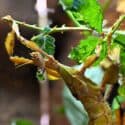
Macleay’s Stick Insect Natural History
Size
Females can grow to about 20cm (8 in) while males are smaller at 11cm (4.5 in).
Habitat and Distribution
They are found in forests on the east coast of Australia in Queensland, New South Wales and Victoria.
Diet
They are herbivores feeding mostly on eucalyptus.
Groups and Breeding
Females are covered in thorny spikes and while they have wings they are too small to fly. While the males wings are much longer allowing them to fly especially when trying to find a mate.
They typically reproduce sexually after which the eggs take 4 months to hatch. Females flick their eggs onto the forest floor by swinging their tails. Ants carry the eggs to their nests mistaking them for food. The nymphs hatch and quickly leave the ant nests and climb surrounding trees.
Threats
This species is not listed by the IUCN Red List.
Interesting Facts
When threatened they may adopt a scorpion-like pose in which stand on the front and middle legs, raising their abdomen up over their back.
The Macleay’s Stick Insect During Your Day Out in Kent
The Macleay’s Stick Insects at Wingham Wildlife Park can be seen in the Bug House alongside a number of other invertebrate species.